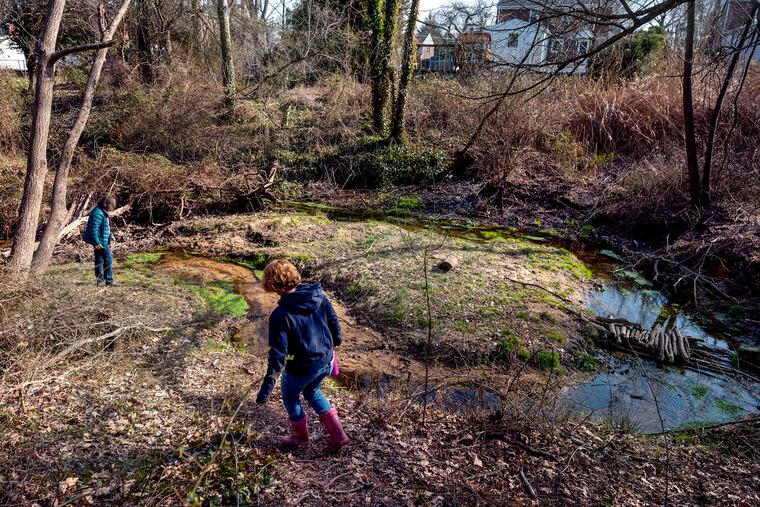Sediment continues to plague Newton Lake, even after its $20 million dredging
An effort to dredge, manage, and improve Newton Lake is the largest single project park in Camden County history. Dredging is done but stormwater management is a sticking point.

Camden County spent $20 million last year clearing out the sediment, goose droppings, and lawn fertilizer that had clogged Newton Lake. But rainstorm after rainstorm, muck is flowing back in.
An estimated 870 tons of sediment are carried into the lake annually by its two tributaries, as well as by runoff from parking lots, driveways, and streets in Haddon Township. Roughly 270,000 tons, including vegetation, were sucked from the waters of the lake by the time the work ended last year.
The Camden County Municipal Utilities Authority, which oversaw the dredging, now aims to ameliorate at least some of the upstream re-sedimentation. A similar effort will be made in the newly dredged westernmost section of the lake, where the Peters Creek tributary annually deposits 728 tons of sediment on the bottom.
Last July, the state Department of Environmental Protection criticized as “deficient” the CCMUA’s proposal to significantly reconfigure waterways, stream banks, culverts, and wetlands, and remove 100 trees to reduce erosion upstream erosion in Haddon Township.
CCMUA is considering rain gardens, swales, and underground stormwater-collection structures.
“The additional work is an investment so that we don’t have to come back in 20 years and do the entire dredging project again,” county commissioner Jeff Nash said.
A chronic condition
Newton Lake is a human-made, high-maintenance body of water that flows for roughly three miles between Cuthbert Boulevard in Haddon Township and the Black Horse Pike in Oaklyn.
Sedimentation has been a problem ever since the lake was created from what had previously been a swampy stretch of Newton Creek in the 1930s. The lake bottom has periodically filled up with sediment and other debris and pollution, which causes mats of aquatic plants to proliferate and algae blooms to turn the water the color of pea soup.
» READ MORE: A walk through Saddler's Woods
The CCMUA obtained a $20.9 million loan from New Jersey’s Infrastructure Bank, payable at 1% interest over 30 years, to finance the dredging project.
Because the lake, which reverts to a creek as it flows through Camden, is a tributary of the Delaware River, its condition is of concern not only to local organizations such as the Saddler’s Woods Conservation Association and the Newton Creek Watershed Association, but also to the Delaware Riverkeeper Network as well.
“Seventeen million people get their drinking water from the Delaware River. It’s important that we treat problems at the source,” said Fred Stine, community action coordinator for the Riverkeepers.
Why not before rather than after?
The sedimentation-control portion of the project is being done after, rather than before, the two-year-long dredging “because the lake was dying,” said CMUA executive director Scott Schreiber. “It was not clear how many more seasons the lake could survive without dredging.”
“In retrospect, it is a good thing we did dredge first [because], we would have been still waiting to get NJDEP approval on the upstream work,” he said. “We’ve been trying to work this out for a year, and the state wouldn’t budge.”
Schreiber said that the CCMUA and DEP had met again last Monday. A DEP spokesperson declined to comment.
“The three-phase project of dredging, stream bank stabilization, and capital improvements is by far the largest of its kind in the county’s history,” Nash said. “It was not done lightly. And we will make it right.”
A single element of the second phase — reconfiguring a stormwater outfall pipe that drains runoff from the Paul VI High School campus into the tributary called Saddler’s Run — may soon move ahead.
The pipe was installed high above the stream before the advent of modern storm water management regulations in the 1970s. The opening will be lowered to just above what is now the dramatically eroded chasm that carries the run downstream.
“We hope to have the permit [application] submitted in the next two weeks,” Schreiber said. “As soon as DEP blesses it, we are going to get out there and build it. We want to preserve the investment that was made in the dredging.”
The bigger picture
The Riverkeepers’ Stine called the CCMUA’s latest proposals to reduce upstream sedimentation “a step in the right direction.”
Watershed association leader Lorraine Prince said local environmentalists “are frustrated that nothing has been done yet about the erosion and frustrated at not being able to have a face to face with the Paul VI or the Diocese of Camden.
“We just want an open dialogue,” said Prince, who lives near the lake and has been advocated for green solutions to its challenges for 20 years. “We would love to help the diocese and the school deal with their storm water problems, which impact downstream.”
Neither the diocese nor the high school responded to requests for comment.
Janet Goehner-Jacobs is executive director of the Saddler’s Woods Conservation Association, a volunteer-driven nonprofit founded in 2004 and steward of the 25-acre wooded area surrounding Saddler’s Run.
Although members of the 300-strong group had issues with some elements of the rejected erosion control plan, “we were very supportive of the need to restore the wetlands” around Saddler’s Run, she said.
“We’ve always been concerned that the [project] was too lake-focused and not holistic,” Goehner-Jacobs said. “It’s great to try to restore Saddler’s Run. But if we don’t look beyond the stream, a solution is not going to be truly achievable.”